Trust me, I'm in advertising...

10 years ago when I started my own agency, an account director mate left the industry to become a real-estate agent. I remember thinking it was the only place he could go that had a lower standard of trust than we advertising types.
Last week he told me it was a great move financially, he reckons 99% of people in advertising are really smart, whereas he’s happy competing with the 99% of real estate agents he’s found to be really ordinary. If we are that smart, why can’t we lift our own profile, beyond the bottom of the heap for trusted professions?
Trust in advertising? This is not an oxymoron.
Unfortunately, the perception of our industry is on a par with used car salesmen, yet our legal obligations, indeed our personal liability, dictate our practices are squeaky-clean.
In Australia, like most things, our industry is regulated and kept on the honest path by a series of laws and regulatory bodies. You wouldn’t know it.
The 2011 senate inquiry into outdoor advertising standards found only 0.01% of ads were found to be bad, i.e. sexist, likely to offend or straight out untruthful. Yet when prompted on ABC radio, the senator leading the inquiry said that if we don’t clean up our act under self regulation, he’ll "pull out the big stick and regulate" us.
Would you trust a politician to decide whether marketers are trustworthy?
In Europe, clergy are experiencing a decline in confidence levels and politicians are in last place. Our peers don’t rate much better than we do here, with over half of Europeans surveyed* saying they don’t like journalists, marketing specialists or advertising experts.
*Source: GfK Trust Index in spring 2010
I can understand why journalists are suddenly on the nose – the phone hacking scandal at Rupert's tabloid News of the World has in the words of one shareholders action group "laid bare a striking lack of stewardship and failure of independence." The board had been unable to set a "strong tone-at-the-top" about unethical business practices.
Australians generally are a trusting lot. When it comes to believing what our fellow citizens say, Australia on a trust index score of 92 ranks ahead of the U.S. (78.8) and U.K (61), just behind New Zealand (102) and way behind China on 120.9.

Source: ASEP/JDS data bank 2011
So where do Australia’s “ad people” sit on the trust index today?
Who we really trust is no real surprise:
1. Paramedics
2. Firefighters
3. Pilots
4. Rescue volunteers
5. Nurses
At the bottom of the pile are
41. Taxi drivers
42. Real estate agents
43. Car salesmen
44. Politicians
45. Tele-marketers
Source: Readers Digest Austrlalia’s most trusted professions poll 2011
Before you think ad madmen aren’t so bad after all, the only reason they’re not last on this list is because they aren’t included in the survey. Tele-marketers are the closest category, so let’s just accept advertising and marketing guys are way down there. How did we end up down at the bottom with pollies, and what do we need to do to elevate our role to a similar level of respect as other service providers like engineers, doctors and architects?
Advertising first took off in America in 1800s when snake oil makers discovered the return on investment of promoting something of little value with amazing claims in the press. In Australia last year the most damage to our credibility was the public complaints about the posters advertising Advanced Medical Institute’s cure for under performance in bed. It was bad enough they were bad ads, the real breach of trust was the pitch was a fraud. Most of those with a desire to last longer in bed were overcharged for a treatment that generally didn’t deliver on the promise.
As a professional I feel we would be better off refusing to work for these types of people. It didn’t harm Bill Bernbach’s career when he told prospects he wouldn’t accept their business if their product didn’t live up to his standards.
(Glenn Mabbott would like to declare his interest as a sitting member of The Communications Council’s Policy Committee, which aims to raise industry standards through the Accreditation Scheme. UNOmarcomms was one of the first independent agencies in Australia to gain accreditation.)
Are today’s retail ads bland, bland, bland?

Are today’s retail ads bland, bland, bland? This was the question posed by AdNews last week after Dick Smith launched a new brand style ad campaign. If you missed it, here is a cut down of my contribution to the debate.

Dick Smith was an innovator
He built a new category with advertising and brochus that gave Australia’s cardigan wearing tinkerers access to an Alladin’s cave of electronics stuff to play with in their garages. What proved Dick really clever was his ability to sell his growing challenger brand to Woolworths and then go on to innovate time and again. With Australian Geographic and then his Australian Made products, Dick was a natural at creating marketing campaigns that resonated with the public mood of those times.
Contrast this with another retail innovator of Smith’s era, Gerry Harvey. Gerry also made his first million in his early twenties with ads for whitegoods and appliances that yelled, “Why pay more?

Is Gerry a clever Dick?
Gerry didn’t sell his business and continues to be the biggest retail advertiser in the country with ads that follow the same tired formula of thirty years ago. We all know the pitch: yell loud enough and people will rush in to grab a bargain. Except increasingly we’ve learnt to treat those ads as repetitious nagging. We’ve moved on to better retail experiences, which are likely to be online.
It’s time the majority of retailers looked at the current crop of retail innovators, like Net-a-Porter that has just released a new magazine iPad app that makes shopping an exciting, contemporary experience. Or this great campaign in Korea for Tesco’s challenger brand, Home Depot.
This article first appeared in AdNews, 21/10/11
A lateral way to increase retail shelf space: use a billboard
Watch this short video of how Tesco challenged the number 1 retailer in Korea by creating a virtual store.
What’s the next killer app?
The latest stats show Australians are the number 2 adopters of smartphones. And this year, Tablets and iPads are set to outsell mobiles, Australians will buy 1.2 million of them*. In the last couple of years the fastest increase in marketing online has been with using video, so we believe the next big thing for marketers will be video over smart mobile devices.

Ask us about the app factory that will let you make the most of video content. (Soon to be launched by UNO with our partners at Mass Media Solutions.)
*Telsyte mobile device update 2011.
73% of CEOs think marketers "Lack Business Credibility"
According to damning research by the Fournaise Marketing Group, marketers are not the business growth generators they should be.*
The gist of the findings of an Asia wide survey of CEOs is that management believe their own marketing departments are in a world of their own. They believe marketers speak in jargon and are not contributing any value to the business. From my experience you can’t blame most business owners for thinking this way, especially in Australia. Too few businesses have ever had a good marketer sitting round the table at board level, championing the power of marketing to generate wealth.
Marketers need to talk the language of business outcomes
As in “how can marketing get a better return on investment”. Otherwise marketing will remain a misunderstood black art not worthy of the attention of three quarters of CEOs. The vast majority of businesses will thus miss out on the huge opportunities that insightful marketing can deliver when it is woven through the entire business process.
Meanwhile there are a handful of businesses doing better than the rest because they have value-adding marketers on the team. These marketers, obsessed with return on investment, are recognised as an integral part of the senior management team. They are helping their businesses punch above their weight in the following ways…
- Overcome competition based purely on price
- Prevent decline of sales
- Hold on to existing customers
- Build qualified sales leads
- Change the perceived quality of a product
- Revitalise tired brands
- Boost staff morale
- Speed the development of new markets
- Speed product trial and acceptance
- Help businesses raise capital more easily
- Build the value of a business for sale
ROI marketing works
For 100 years Coke has proven it, people from first world countries to third choose Alabama’s black sugar syrup even though it doesn’t taste as good as Pepsi’s. That’s the power of consistent marketing. Perrier taught us to pay more for mineral water than petrol. Branson has convinced Australians to fly Virgin despite having a deplorable record of taking off late, (and you still have to pay for your sandwiches). And thanks to marketing Apple has built a brand that is hugely profitable, marketing has enabled them to sell often inferior spec’d products at a premium to specialist manufacturers like Nokia and HP.
CEOs needn’t fear marketing speak. Business decision makers who embrace marketing with an open mind can still enjoy a sense of control by implementing a test and learn approach. Any marketer worth listening to understands the value of having the results of their work tracked. If it isn’t measured, it isn’t managed. A marketing program that IS managed WILL deliver better results than mindlessly sticking to what the company has always done, or jumping blindly into the latest thing.
ROI Marketing can make a big difference to any sized business, in any category
So what can ROI marketing do for you? My experience has shown me whatever the category, from Watties baked beans to Brita water, Splash Clinic cosmedical treatments to City Index CFDs, a test and learn marketing program can turn good businesses into category leaders.
Read MoreTwo thirds of Australians are using social media. Two thirds of those use it to decide what to buy.*
Social Media Marketing (SMM) is growing, the latest figures show Social Media is becoming a mainstream influence in the purchase decision process. UNO are members of the Australian Interactive Media Industry Association. Together with Sensis, AIMIA surveyed 803 Australian consumers and 1,944 Australian businesses to determine how social media channels are being used. 50% of corporations now have a social media presence, the majority on facebook. Just 14% of small businesses use social media.
Proportion who have Social Media presence

Proportion who have Social Media presence

Social networking site usage by age and gender

Here are 10 ways you can make more of Social Media in your marketing communications mix:
- Start now for free. If your business is consumer facing, get a facebook page, it’s free.
- For B to B, skip facebook. Focus where business decision makers are active. Join LinkedIn. Follow relevant associations and groups, join industry forums and post comments on articles.
- Share your knowledge. Your business is your passion; tell it how you see it where you can add value to a conversation. No need to sell, just build your credibility as an expert and you’ll be increasing the standing of your businesses.
- Don’t post as anonymous. Out yourself. The CEO of a solar hot water manufacturing company follows chatrooms where plumbers share advice. His comments to tradies‘ questions demonstrate he’s in touch with his market. I suspect his competitors are unaware such forums even exist.
- Put someone in charge of your Social Media. Empower a person within your business who is passionate and keen to have a dialogue with customers. If you don’t have anyone internally, outsource.
- Tweet. Reinforce your position as an industry expert by tweeting and re-tweeting about relevant content that others have shared.
- Blog. Blogs and reviews have a big influence on buying decisions, with 63% of social media users reading reviews before making a purchase decision.
- Be regular. Respond quickly.
- Integrate social media. Integrate content with your promotions and product campaigns. Measure. Track.
- Video is the future. It’s the fastest growing area online because it’s easy to share. It’s not enough to post a television commercial on YouTube because no-one will look for it. Be creative, film an interview with an expert, or shoot a behind the scenes glimpse that showcases something you do well.
Social Media can deliver a measurable ROI. No wonder businesses are spending 5% of their marketing budgets managing and creating content for social media.
The good news is that any business that has collected data on their customers is sitting on their own potential gold mine. Rather than spend money trying to appeal to new prospects by running press or even online ads, you will get a much better return on investment by adding some intelligence to the way you manage your data.
Give your CRM some Data Intelligence
Most data is in such a mess it offers little insight to business owners. To turn it into a powerful tool to enable you to communicate with your customers requires a clean, intelligently organised database.
The place to start to release the value from the mountain of data you already have is to give it to an expert to wash it.
You’d be surprised how many emails and addresses are wrong, repeated or out of date. You can’t begin to measure response rates until you know the data you have is clean. It’s better to measure the response from 10,000 real customers than to assume you’re sending offers out to say 30,000 on a dirty list.
Once you have a clean list, your data then needs to be structured and categorized with the aim of maximising its usefulness for marketing purposes. There are then some things you can do straight away to not only deliver quick profits today, but also set you on the path to delivering what customers will want in the future.
Fast profits can come from testing and tailoring offers to:
- up-sell, getting customers to buy more valuable products from you
- cross-sell, encouraging them to add something else to what they usually buy from you
- increase purchase frequency, by building loyalty and giving them more reasons not to be tempted by your competitors
So get the experts in quick smart to professionally clean your data so you can secure the future of your business. Let those who continue to spend big to tempt new prospects pay the price.
Read More
What will it take for retailers to stay in business in this rapidly changing global economy? Futurist Ross Dawson commented in a recent blog that if you expect your business to look the same in 10 years as it does today, expect to be out of business.
Who’d have thought ten years ago that Woolworths would be the biggest owner of pubs and bottle shops today? Constant change is the only way to stay competitive, which explains why Woolworths just bought Cellarmasters for $340million. Kevin Luscombe recognises the future includes database marketing, Cellarmasters “will enable us to serve a whole new customer segment in terms of the direct marketing channel.”
eCRM drives online sales
Cellarmasters has the largest databases of drinkers of premium wines in Australia. For any competitor to stay in the premium wine business they’ll need to at the very least match the way they apply an eCRM program to their database.
Once a database has been professionally cleaned, you can start to mine your database and build a series of profiles of your customers. Using that intelligence will deliver a better ROI on your marketing. You’ll get a better result cross selling Pinot Gris to customers who are heavy purchases of Sauvignon Blanc. With profiles of your customers it becomes practical to promote a 20 case limited offer Coonawarra cleanskin, you simply email your regular purchasers of Cabernet. With data intelligence, while you offer a bonus with purchase of single malt to spirits drinkers, beer drinkers automatically receive a different offer.
Very few customers want to be constantly bombarded with promotions that are obviously being sent to the masses. They will reward targeted offers that demonstrate you understand them as an individual with stronger loyalty.
Your customers know what they like and will actually tell you what they want if you bother to track their behaviour, or quite simply ask them. Every marketing activity, from a mailer or catalogue to a visit to your store, each phone enquiry and every online order is an opportunity for you to measure what works and what can be improved.
ROI marketing will drive e-commerce
Every dollar you spend on marketing should and can be measurable. You don’t actually have to be a futurist to stay in business, with data intelligence you can keep track of where your customers’ needs are leading and continuously adjust and improve to keep up with them.
Read More
Bernard Salt earns a living as a demographer. That’s the art of taking research data and painting a picture of who we are and what we think and do. Before you tune out thinking he’s just another propeller head making money off the back of lies, damn lies and statistics, consider for a moment what you’d give as a business to know where the next big opportunity for making money is, before it happens.
How do entrepreneurs know where to invest today in what will be the sweet spot tomorrow? What did the savvy few who bought franchises in McDonalds in the eighties know? Or the food services that were ready to be part of café culture as we left tea drinking behind?
If you were a tea manufacturer in the 70s Australia’s demographics could have predicted that your volumes were about to decline. The move from a society of tea drinkers to the blossoming of café culture at the turn of this century was a consequence of something that happened in the 1950s. The wave of immigrants from Italy and Greece post war had kids, grew wealthy and infused our Anglo society with a Mediterranean café culture which saw Australians move onto the footpaths and embrace machiattos and cappuccino with biscotti in preference to sitting indoors with a cuppa Bushells and an iced Vovo.
At a Family Business Australia breakfast, Bernard explained the simple truth that the composition of Australia is what drives business growth. And decline. Seems obvious, yet even the high fliers at BHP and the big four banks pay Bernard to keep them abreast of what should be self evident. It’s easier to grow a business and be profitable in a category of growing demand than to compete for a share of a shrinking one.
Change managment – there's money in tea
Follow the demographic trends that will shape what Australians will look like in the next decade and consequently what consumers will be asking for. Today there is a shift away from European immigration to Asian as these stats on fastest growth and loss by place of birth show.

Prediction: Start thinking about tea and noodles not coffee and pasta.
Super was yesterday’s money maker
In the last decade the biggest growth in financial services has been in superannuation. The SMSF category has doubled its share to be the largest segment at huge cost to growth of retail funds as boomers take more interest in their money in super. Industry funds have also grown share with a low fee proposition and the locked in stream of contributions via the super guarantee levy from a membership base that traditionally wasn’t saving much. But that’s today’s boom business, tomorrow it will change, again because of a shift in demographics.
The makeup of working Australia is about to fall off a cliff, as the boomers retire and are replaced by… no-one:

The age at which boomers will retire, now on average 58, as well as the length they can expect to live has also profoundly changed in just a generation:

Prediction: Cashed up retirees who will live for 20+ years will want to travel, eat out, be entertained, live in a city apartment or by the sea and to pay for it all need a retirement pension plan that will last the distance. They’ll be looking at ETFs and annuities.
Bernard Salt has a pretty good idea of what tomorrow looks like. It’s up to you to see how you can position your business today to be ready to reap the rewards of a growing market category before it’s the next big thing.
Read MoreDoes your business have a brand policeman?

When did you last check your brand imagery and how consistently you are projecting your business to customers and stakeholders? Have you done a complete audit of all your “touch points”? Who in your company has the authority to enforce standards?
Large corporations have entire departments looking after how the image they present visually. They have realised the value created by consistent repetition of the company brand marks alongside the product or service it delivers.

Most businesses fail to present themselves as professionally as big brands and end up with a brand “look” that has more in common with a camel than a racehorse. This occurs organically, by allowing too many people to make piecemeal decisions every time something is needed.
There are so many pieces that make up the complete picture of your brand, from a new business card to printing a brochure or sending an email offer. Each is an opportunity to build brand “credits”, or a risk for someone to go off on a tangent.
A complete audit of all your brand “touch points” would cover:
• Internal signage
• Building signage
• Banners
• Vehicle signage
• Advertising
• Email signatures
• Website
• eNewsletter templates
• Fax formats
• Letterhead
• Business cards
• Presentation folders
• Flyers
• Sales force and sales kits
• Product sheets, warranty forms
• Order forms
• Invoices
• Branding on your products
• Point of sale
• Price tickets and notices
Setting brand standards with a professionally developed Style Guide
Brand guidelines (also called a Style Guide) should cover all of the things in the list, and have specific rules for each element. For instance, how your logo is used would cover these specifications:
Colours
• Print: CMYK or Pantone reference
• Digital: RGB
• Mono, reverse,
• Vector files for artwork production.
Size guidelines - how small can it still reproduce?
Usage guidelines - clear space, location on the page, hierarchy with other symbols.
A Graphic Designer with credentials in this area can produce your Style Guide.
Enforcing your brand style
Your creative agency can act as your deputy and arm you with a password protected online archive of logos, images, artwork formats and templates.
Many businesses also find having a professionally developed Style Guide available, as a reference document for staff and suppliers, helps enforce brand rules making it easier to keep the company image under control.
Finally, someone qualified within your company needs the power to enforce the Brand guidelines. It is possible to mandate that all work using the company brand mark is approved by this person before it goes into production.
Success through consistency
Every business can benefit from designing formal brand “rules” so they can weave simple and consistent imagery through the company’s everyday operations. If you have a good product your customers will come to associate that product with your consistently delivered brand mark.
Read More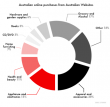
There’s more to ecommerce than GST
Funny how Harvey Norman and other retailers are running to the regulator with the sob story that they are losing sales to overseas online providers who don’t pay GST. Time for a reality check, they are losing sales because they are slow in changing their business models to keep up with consumer behaviour. 6 months ago I flagged the stats showing how quickly online sales were growing and the failure of our retailers to keep up with the trend.

Consumers reward innovation
It’s how Gerry Harvey made his first millions when, in his twenties, he founded the first category killer electrical discount store, Norman Ross. You don’t have to be young to be innovative; you just have to give consumers what they want in new and exciting ways. Today consumers increasingly are researching and shopping online. In a few years what they want will be something most of us have yet conceived, and more than likely Apple’s Steve Jobs, aged 55, already has in development.
Facebook keeps growing. So how can you make the most of it?
Facebook has broken through the 10 million barrier of active users in Australia*
While this will prompt many to jump in and increase advertising on Facebook from the current $12million a year, content is the cost-effective way any marketer can gain exposure to this increasingly significant audience. Best make sure it's the right kind of content.
Online content is King
When publishers and marketers say content is king, what exactly do they mean? Here’s an example close to my home. When I was 20 I played occasionally in a punk band called The Coathangers. Most nights we were lucky to get paid in free beer, the cover charge might be a couple of bucks. One night we had 6 bands for 69c. It was accepted that routine you played for little or no immediate return to build up an audience. Later you would then sell records to them, which was where the money was. Your loyal following paid for content.
Today you can’t expect to sell many CDs when everyone can download your content for free. My 21 year old son has a new band, The Psychonaughts. They hardly ever play live, they are busy recording, creating content that will more than likely be given away. In the not too recent past a band would build a website that fans would visit to purchase songs and buy merchandise. Not any more, people expect everything online to be free.
So what’s the value of giving away content online?
In the case of music, the content gets passed around and builds an audience, who then pay to see you perform live. Technology has turned the model upside down.
The ease with which people can share content across social media is a lesson for brands – we are now in an era where you have to produce content of value to your target audience, making it available for free. It then requires like-minded prospects to share it by whatever medium they choose: YouTube, mobile-to-mobile, email, or increasingly, Facebook.
According to Facebook regional vice-president A/NZ Paul Borrud, globally two-fifths of the more than 500 million Facebook users are accessing the site through their mobile. And Australians spend longer on the site than anyone else.
Unlike marketing via your brand site, or Google adwords, or banner ads or traditional mass media advertising and PR, the consumer isn’t being paid to publish your message. For content to be spread it isn’t enough to post brochure copy or press releases, content needs to be engaging stuff that your customer sees value in. And by aligning this free content with your brand story you can build a relationship with prospects stronger than an advertising approach could ever achieve.
So the art is producing content that is worthy of the attention of your audience, something they want to share.
* SMH.com.au 10/12/10
Why the CEO has to be the chief blogger

Successful social media strategy starts at the top of every business
It's misguided to think social media can simply be delegated to the youngest in the business, or outsourced to a digital agency. Social media is simply another relationship management channel. So it makes sense the strategy of what will be discussed in social media and what won't lies with the CEO. Social media is the one place the CEO's message can get through direct to the individual, without being filtered.
So if you're the CEO, consider this medium as your direct way to have a personal conversation where you can champion what you believe in. Before you begin, reconsider what you want your business to be known for. Ask yourself what is at the heart of why people should buy from your business, rather than your competitors?
Recent research by PR firm Weber Shandwick shows social media has positive impacts on business. (Click to enlarge.)
This simple checklist will help frame the social media agenda for your business
- What is the purpose of the business, what will success look like?
- What is the business strategy?
- What does the business believe in?
- How does it add value?
- What are its beliefs and ethics, its reason for being, its mojo?
- What is the business story? The way you express your differentiation, the reason for customers to choose you.
- Who does the business want to help? Who do you want to leave for your competitors to lose time or money trying to please?
- Who does the business want to influence? The gatekeepers to your prospects, or perhaps the well connected people who might bad mouth you through ignorance?
- Who does the business want to work with? Do you have affinity partners or associations you can share your blogs with?
- What kind of people does the business want to attract? It now matters what you look like in the blogoshere because it's the first place most potential employees will check you out.
Reputation risk has been elevated by social media
As equally important as having a social media presence is what you say. Being active across social media brings new risks. What is published online stays online, potentially forever. No wonder reputation risk is now the number one concern of CEOs globally according to the latest report from Deloitte.
Perhaps if more CEOs took control they would minimise the risk of staff who know less being the main originators of social media conversations. The CEO is best placed to set the agenda, staff can then follow through.
According to research by Weber Shandwick, more than six in 10 CEOs are already posting content on company websites. Yet only 18 per cent of the CEOs surveyed participated on social networks. The chart above gives an overview of the survey findings. Interstingly, 80% of staff want to see their CEOs on social media, largely because it's where they want to keep up to date.
I feel most CEOs I talk to are missing this powerful opportunity to spread the truth about their business vision. Social media is where these truths are shared and discussed, it's one place the leader can champion their cause with passion.
Read MoreWhat makes mid-sized businesses more profitable than big?

So what is a mid-sized business?
GE Capital has been defining the mid market in Australia as businesses that have annual revenues of between A$10 million and A$250 million. Average firm turnover is about A$41 million. Despite comprising just 1.4% of companies by number, mid-market firms provide one in four full-time jobs and contribute A$425 billion annually to the economy.
The federal Department of Innovation, Industry, Science and Research, which has a broader definition of medium-sized businesses as those with between 20 and 199 employees, puts the economic contribution of the mid-market considerably higher.
The mid-market campaign we successfully managed over four years for IBM targeted businesses from 99 and right up to 999, the large corporate and government sectors that IBM traditionally owned really kick in around 1,000 staff.
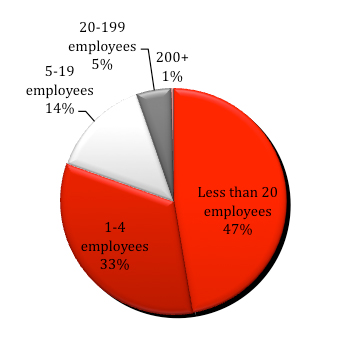
Australian Business
Most mangers still hold the belief big means better. We hold a belief businesses can only succeed today by being nimble. The reason for this is the profound change the Internet has brought to our lives. The world even quite recently was quite slow to change, and most businesses were relatively simple. Today we all compete in a world of rapid paced change and increasing complexity. So the old big business model of slowly and effectively finding savings from gradual improvements to products and services and small efficiency gains in management and procurement are no longer enough to stay competitive. Let alone stay in business.
The evidence for the decline in profitability of big business is seen in this chart. It shows one third of market leaders in their category in 1950 were also the most profitable businesses in their category, whereas today being big almost guarantees you’ll be struggling to make a buck.
Market leaders that are also category profit leaders:
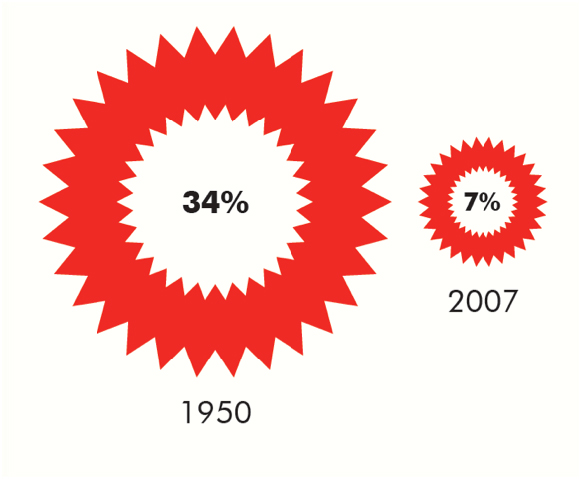
What makes big business vulnerable to challenger brands
George Shinkle is a Lecturer in the School of Strategy and Entrepreneurship at the Australian School of Business. He has been studying why big business is failing.
“Organisations grow large by becoming more efficient, so when you’re really focusing on efficiency you typically become less and less flexible. The rules and processes and procedures become more and more about keeping you efficient, constraining your ability to be flexible,” he says.
“If you talk to the CEO of a very large firm, they don’t feel as if they’ve got direct control of what the organisation’s really doing. They give guidance and they set policy but the organisation has some variance on how well they follow those things,” says Shinkle.
The learning you can take advantage of is that managers in large companies try to hide from change. Which is why, if you’re running a mid-market business, you will create your own advantage by actively seeking out things to change to differentiate from the competition.
Not too big, not too small, mid-sized business is just right
Big business is still obsessed with conformity, groupthink and doing things the way they have always been done around here. Small businesses may be the birthplace of great ideas, but they usually don’t have the scale or resources to commercialise those insights.
The mid-sized business is perfectly placed in the middle, where the distance between innovative thinkers and management that can actually make decisions is short. Unlike small business, resources aren’t so slim ideas can’t be trialled without damaging the existing business of running the business.
At a CEO Institute meeting Susan Lenehan told me the biggest frustration of the CEOs of Australian arms of global businesses she mentors is their total lack of autonomy. They are prescribed what to do by head office irrespective of local circumstances. In her words, it’s the pinnacle of the “bully culture” of big business management.
Challenger brands will prosper by taking risks
This is the great opportunity mid-sized Australian businesses are exploiting, they can leverage their ability to try changes, while the big guys are stuck in the inertia of business as usual, with its five year plans, annual targets and quarterly reporting. By challenging traditional big brands, Australians can be globally competitive in a world that is changing daily.
The real successes come from maximising returns by minimising the risks of change – we developed the challenger brand formula for growth for this very reason.
Why you need brand awareness before sales
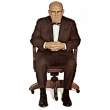
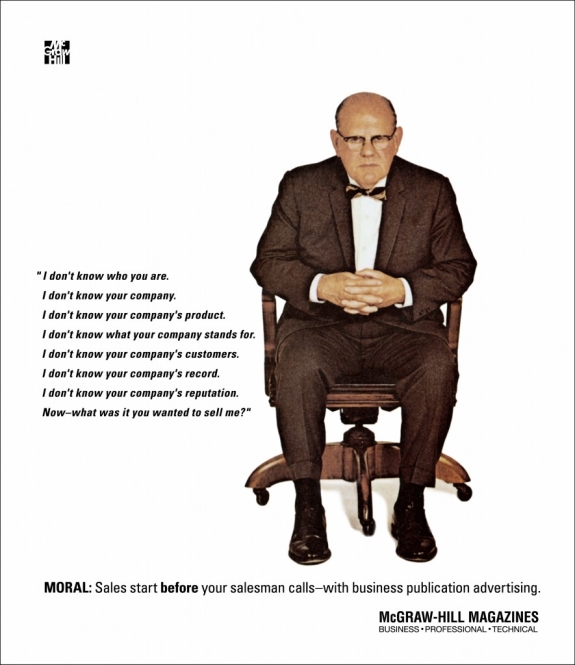
This famous ad for advertising with McGraw Hill appeared in 1958
Business owners sometimes need reminding of the timeless challenge, why would a prospect buy from you rather than one of your competitors?
For 50 years the simple answer was to spend more on advertising than the rest of your category. As marketers now realise, simple strategies in this Internet enabled world now require more complex solutions.
Challenger brands can succeed today without big ad budgets
The good news is smaller businesses can now be successful challenger brands with smaller budgets than the big brands. The staring point is to differentiate. with a singleminded story that prospects will value. you can then apply a test and learn approach to marketing across multiple mediums. Smarter strategies applied with insight will now succeed while big spending inflexible brands continue to struggle.
Read More73% of marketers say more has changed in 2 years than the past 50


Who are you going to call to advise your business on how to grasp the rapidly expanding number of marketing communications options? Usually you’d call in an expert. However, the pace of change right across the business world and the complexity of competing solutions is so great how can any individual be an expert? And big businesses may have lots of individuals, but we all know they rarely work as a team let alone communicate well with clients.
Marketing professionals are confused
A survey* by Adobe of 1000 marketers in the US shows the crisis in confidence of the marketing services.
“Marketers are facing a dilemma: they aren’t sure what’s working, they’re feeling under-equipped to meet the challenges of digital, and they’re having a tough time keeping up with the pace of change in the industry. What’s worse, no one hands you a playbook on how to make it all work,” says Ann Lewnes, Chief Marketing Officer, Adobe.
Digital marketing is full of novices
Adobe’s survey found less than half (48%) of marketers who consider themselves primarily digital specialists feel highly proficient in digital marketing. Most digital marketers haven’t had any formal training in digital marketing. No surprise really, it’s so new and evolving very few places can teach it.
The problem for business owners is how to leverage what’s new when so few people, if indeed any, know what will work. The people whose job it is to know, professional marketers, revealed in the survey the same old issues are today’s top challenges. 82% cited reaching their customers as the biggest challenge, then the uncertainty of knowing if their campaigns are working (79%), and measuring campaign effectiveness (77%) and marketing ROI (75%).
The answer for marketing your business?
Today every part of the business has to take risks
Whether it’s your accounting systems, distribution, IT or marketing, everything now is facing change. It’s hard enough to know the right question to ask anymore, let alone have the right answer. The safest option today is counterintuitive – it’s to realise you can’t predict winners anymore.
So the safe approach with marketing is no longer to set and forget. Rather than taking a long time and spending a lot of money attempting to develop the one perfect solution, try a lot ideas and mediums. And try them quickly and often.
Test. Learn. Adjust. Test again.
Learn to feel comfortable with failures. Set out to make the risks small so the stakes aren’t too high. Then go for it with a test and learn approach to marketing. The more often you fail the quicker you’ll find yourself challenging the competition and being successful.
* Source: Adobe and Edelman Berland, online survey among a total of 1000 US marketers. Marketing Staff (n=499), Marketing Decision Makers (n=436), Digital Marketers (n=263), and Marketing Generalists (n=754). September 2013
Read MoreAre fashion retailers training customers to buy on sale?
I've written in the past how Zara led the world by applying just-in-time manufacturing and data analytics to bring us fashion forward product design. This has given them an advantage over traditional retailers by circumventing the traditional seasonal approach to fashion.
Instead of waiting for the leading designers to reveal on the Paris catwalks what we'll be wearing next year, Zara's innovation was to take the Dell Computer model. Zara replenishes stock in their stores every week, see what sells, then make more of what is popular. Rather than sitting on large quantities of stock hoping people will like what style you've backed, Zara take a test and learn approach. They never back one colour or style for a full season, Zara simply adjusts what they manufacture on the fly to what the consumer wants this week.
Fashion challenger brands risk destroying the advantage they have created
Retailers are losing the power to maintain margins by encouraging a buy on sale mentality. According to Robin Givhan, the only clothes critic to win a Pulitzer Prize, with the constant turnover and turnout of items due to the ever-quickening fashion cycle, there’s no need to buy anything at full price anymore.
While bloggers and fashion critics have used social media to drive awareness and demand of the weekly fashion cycle, retailers she says are to blame for the loss of their pricing power.

"Retailers talk a lot about how the availability of show images pique the interest of consumers before the clothes are available. But I blame retailers for creating a system in which they want spring clothes in November and more shipments every five second[s] and then putting things on sale when they've only been on the racks for one second," said Givhan.
Consumers usually don't know how to establish the value of something, it's actually within the power of the seller to frame the price that they will believe is fair.
Innovate for pricing advantage
If you have innovated your way to a price advantage, don't throw away your smartly won margin. Instead, decide how you can frame the price as fair value, for instance in terms of more for the same, or faster for the same, or better for the same. Offering something for less is an approach fashion retailers are finding comes at the cost of not just profit, but long term survival.
Don't drive your category to the bottom the way Persian Rug stores have, where in every corner of the world the SALE sign on the window now means OPEN. Here's one I snapped in Hong Kong...
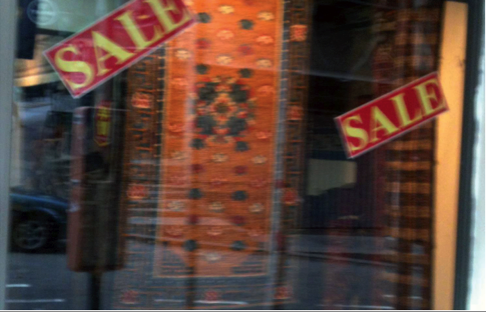
Do you have a clear point of difference to drive growth?


Staying in business has never been harder. 10,632 companies collapsed in the 12 months to March 1 2013 - ASIC also reports the number of firms being placed in administration is more than 12 per cent higher than during the GFC. Over the last few months an average of 44 small businesses were closing every day according to ABS data.
A change of government won’t change the fact the pace of change is still accelerating, the choices for customers continue growing and the decisions we all face in life are more complex than ever.
Where will your business growth come from?
These are your options:
- From existing clients
- By getting new clients
- Expanding to new locations, (interstate, overseas)
- Developing new services
- Making acquisitions
90% of businesses focus on number 1, selling more to current customers or charging them more. Yet the upside is limited.
Of the small number that go down the acquisition path most are disappointed. An AGSM survey of mergers and acquisitions showed after 3 years just 10% exceeded expectations of synergy and only 10% - 15% met expectations. The rest had failed or were in a death spiral.
Expansion and new product or service development often require a large commitment of resources and takes attention away from the existing business.
Which leaves new business as the key driver of growth. Marketing is the one proven method that can drive scalable new business growth. A successful new business program begins by confirming you have a differentiated offer relevant to today’s customer. Every prospective customer has more than one choice. What does your business have that makes it so special they have to choose you?
Customer alignment, simplification and innovation
Here’s a simple technique that GE Capital employs to keep their business differentiated in this time of rapid change. 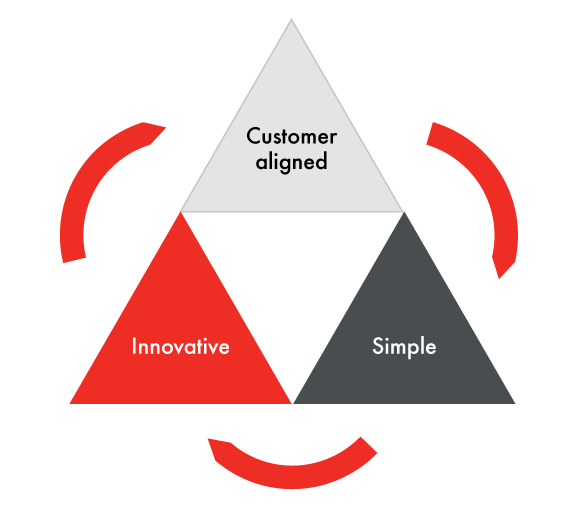
Customer aligned
- Employees know which customer segments we serve and what their top 3 needs are
- Our organisation rallies around these needs (customer facing & support departments)
- We continuously track customer metrics at a transaction, product and business level
- We respond to customer feedback fast
Simple
- We do less, better
- Our customer processes are intuitive
- Our internal processes are as easy as our customer processes
- We routinely identify and eliminate the bottom 30% flow value processes, reporting and meetings
Innovative
- We encourage, empower and reward staff who challenge the status quo
- We launch new ideas fast (< 45 days average)
- We have a full pipeline of ideas linked to incremental volume
- We invest a significant amount annually on innovation
Differentiation for new business growth
Don’t hold your breath waiting for the government to simplify regulation, align their policies with your needs or innovate the country’s way to prosperity. Look at your current structure, reconsider what the business currently offers and determine a positioning that will differentiate you from your competition. Today.
This is just one of the tools UNO uses to ensure when our challenger brand clients invest in marketing, the returns will be worth the effort.
Read More
There are few categories more sophisticated at marketing than fast food. For 50 years McDonalds has been fine-tuning their brand marketing driven machine in Australia. Other brands may talk share of voice or share of wallet, McDonalds is famous for wanting the largest share of stomach in the country.
The business is a great example of how to upsell, cross sell and find new reasons for customers to visit. From breakfast muffins through burgers and happy meals to soft serves and late night treats, washed down by McCafe coffees in between. From Pasta Zu to chicken nuggets to who knows what else a machine can transform animal castoffs into.
Want fries with that?
All of these tactics are an excuse to get more people to buy fries more often, it's where the big profits are made. Makes you wonder how anyone can compete? If you don't work for an omnipotent global business there is evidence of hope. Roy Morgan reasearch released in August 2013 shows just how well new competitors can do by choosing to take a challenger brand positioning.
A case study in how positioning can outsmart the big brands
Hungry Jacks came much later, and has never had the footprint or the ad budget to compete head on. What has worked long term for Jack Cowin's fast food challenger up against a global heavyweight, is a differentiated positioning that gives it a clearly defined space to compete in. "The burgers are better at Hungry Jacks."
From day one they lived up to that positioning statement, better burgers; either with biigger burger patties, actual lettuce instead of a miserable pickled cucumber, to the first Angus beef burger, then bacon and now organic beef. Single mindedly niche focused, and better for it in the minds of customers, who consistently rank Hungry Jacks above Maccas.
Long-term customer satisfaction in fast food comes from smart positioning. Chart: Roy Morgan, August 2013
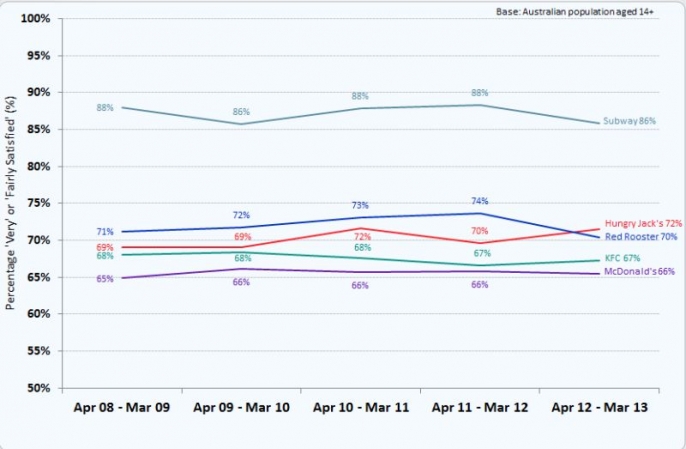
Challenger brands create new terms to compete on
Subway shows the rewards of zigging when the competition zags. While fast food leaders spent their product and promotion strategies on short term price promotion or new themes, from changing with the seasons, think summer pineapple burgers to following fashions, think cajun sauce. Meanwhile Subway went where no fast food had ever successfully gone before: the good for you. positioning.
The chart shows the relative strength of Burger King's "do less of the same, better" approach, and Subway's "do something completely different" model. Both are positively recognised by the consumer and continue to command a price premium to the slower to innovate fast food competition.
What size is a typical marketing budget?

How much is the right amount to invest in marketing?
Depends who you ask. The CMO Council asked hundreds of chief marketing officers around the world across categories how big their budgets are. While this was post GFC, it gives us a useful benchmark when planning ahead.
The starting point for setting a budget uses a top down approach based on your revenue. The chart we've made below shows the percentage of revenue invested in marketing by business to business firms.
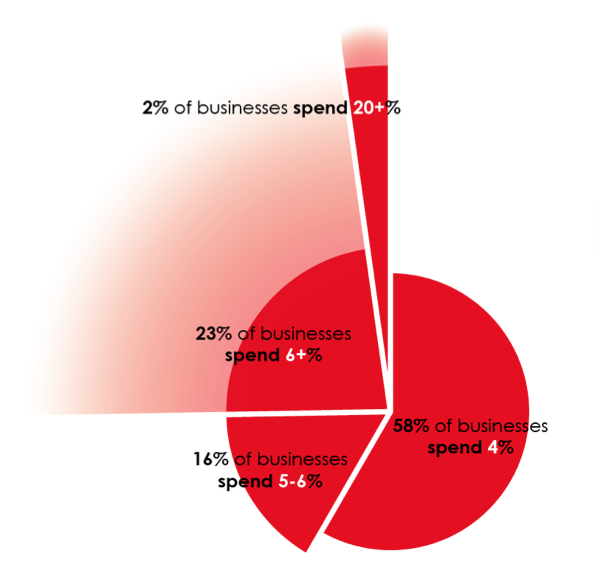
Percentage of revenue invested in B2B marketing
2010 CMO Council Survey
Interestingly, the consensus view amongst those surveyed was that a new brand launch required a minimum investment of 20% of revenue. As we can see from the chart, either there aren't many new brands launched in any year, or the majority aren't spending enough to ensure they don't fail.
Another way of determining the right size of budget is to compare how much is spent according to the size of the business.
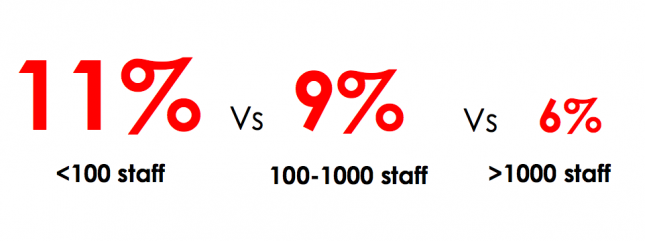
Percentage of revenue invested in marketing by company size
2010 CMO Council Survey
We shouldn't be surprised that as businesses establish themselves and grow, the number of staff grows. As they grow, the relative proportion of their revenue invested in marketing decreases. Marketers understand the long term nature of judging the return on investiment in marketing. Marketing that is consistant delivers compounding returns, a relatively large initial spend will pay dividends in the long term.
Average marketing budget for FMCG brands
A Go-to-Market survey in 2012 found this spread of investment by revenue of FMCG brands:
% of revenue % of companies
No budget 1.1%
0 - 2% 28.6%
3 - 5% 33%
6 - 10% 21.1%
11 - 15% 8.6%
16 - 20% 4.3%
20%+ 3.2%
You can use these percentages as a starting point for framing your marketing budget and then compare to the result of viewing your requirements from a bottom up view.

Bottom up marketing budget approach
Create a list of activities you plan to undertake across your integrated marcomms plan and estimate the required investments for each. Balance and adjust for frequency, reach and coverage. Consider set-up costs for all mediums and a realistic figure for content creation and creative, remembering the better the idea the less times your audience needs to see it to get a result. Factor in research and tracking and an allowance to have the flexibility to react and respond. Remember to allocate around half your total budget for labour, across both internal and outsourced agencies for development and management throughout the year.
Depending on the particular segment your brand is in, the consensus is a B2B marcomms budget needs to be between 3 and 6% of revenue and for FMCG between 6 and 12% to have at least a competitive share of voice.
Read MoreThe most and least trusted professions
Every year Roy Morgan releases a ranking of the trust Australians have for each of the professions. Advertising is down and real estate salesmen up in 2013.
Here are the jobs as they rank for trust in Australia
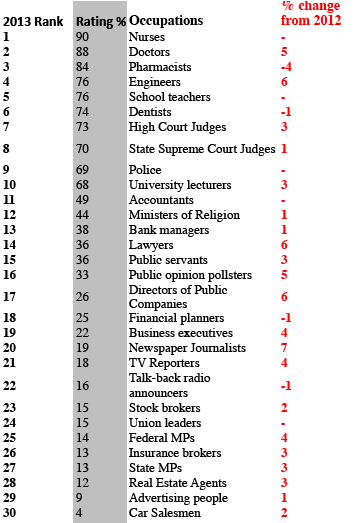
How does this compare on a global basis? See the global trust index.
Read MoreThe Naked truth on Rudd's interview for ads scandal

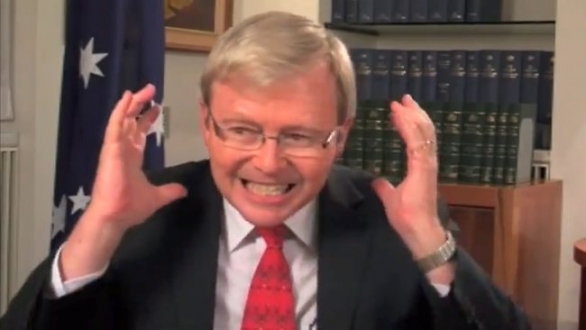
You probably already have an inkling the public rate marketers and ad people at the bottom of the trust scale for professions. You're right, they are down there with politicians. Something happened this week to reinforce the view that neither can be trusted, it's a classic example of an "whatever it takes who cares about the ethics" attitude.
Controversy blew up when Sydney based Naked Communications was exposed while working on a project for Labor when it offered video interviews with PM Kevin Rudd to online youth publishers in return for free online ad space.
Further blurring the lines between “an interview”, and an ad campaign, the agency wrote to Faifax owned The Vine they were “particularly keen for a deeper relationship (including putting investment behind your content on YouTube).”
They also encouraged the online publication to provide “access to pro-Labor or pro-NBN talent.”
When found with their pants down, Naked were fired by Labor. The Sydney Morning Herald’s political reporter, Jonathan Swan, who broke the story, said “it seemed very odd” that Labor was oblivious to the deals offered to online youth sites.
The agency’s CEO claimed no knowledge of the deal, blaming a younger staff member. Indeed, the day after it blew up the agency planner responsible was “no longer in the building”, having left for a holiday in the UK.
What has been adland's reponse to this question of maintaining standards?
Next day the Creative Director of Wonder wrote in AdNews “how much responsibility are we giving young and inexperienced executives? I think too much. Our industry is more impressed by 20-something backward baseball cap-wearing gamers that impress us with their social media savvy than wise old owls. Where are our wise old owls? Nobody could ever accuse the marketing industry as one that eats their young. Quite the opposite, we assassinate the old and we call anyone over 50 old. Mike Wilson (CEO) is Naked’s wise old owl and the bloke is only in his 40s.”
He then suggested the team at Naked vote Abbott to avoid a Labor backlash. This received some wise comments, my favourite from No Wonder of Paddington:
"Wisdom is not the province of age, and this is not an 'odd judgement error'. It's a failure from top down to create a culture of ethics... that at all times forces doing the right thing to trump making a splash for your client. Wilson may be the straight shooter he's characterised here to be, but as the leader of the pack, he's ultimately responsible for the culture that would spawn the actions of that 'rogue executive' who was shown the door"
"This isn't the first time that Naked has been guilty of pushing the envelope at the expense of common sense, and more importantly common decency. What's worse is that the creative drive to market at any expense has had a poisonous influence on the business in general, and in some corners legitimised the art of the stunt and the bad habit of erasing the moral line to such an extent that many of the young guns don't even know it exists."
"It's the agency that should take the fall in the end, not just the employee directly responsible, and encouraging them to vote for Abbott in an attempt to avoid the negative reaction from everyone that they richly deserve shows us all just how jaded the industry at large has become. Sad and sadder."
SMH's Swan labeled the agency “a bit wild west, they’ve got a cowboy reputation” and said they have a history of “doing things a bit off-piste”. Swan also mentioned the infamous fake Facebook Witchery coat campaign which duped both mainstream media and social media users in 2009.
When does online content become advertising?
According to the ACCC and AANA it’s one and the same in the eyes of the law, as we can see from the new Code on marketing communications that encompases social media.
Gabriel McDowell, MD of PR firm Res Publica pointed out the new risks inherent in attempting to leverage digital channels: “From a crisis management perspective, and based on the reported facts so far, I think the ALP has reacted promptly and appropriately to try to limit reputational damage to the Labor brand. They have made it clear they didn’t sanction the offending proposal and firing the responsible agency was a justifiable response given the seriousness of its misjudgement.
"And there can be no doubt that it is a whopper of a misjudgement because building trust and understanding between a brand and its public is the fundamental objective of any communication campaign and deliberately blurring the lines between editorial and advertising can only erode trust when it is uncovered.”
"It has never happened before. My mouth was on the ground. Young people are politically engaged and this is not the way to go about appealing to them. It is why we tend to shy away from the major parties."
She told AdNews it was "exactly the sort of thing that is killing media", but that brands generally grasped the value of editorial over paid content.
The challenge for the communications industry is while we may have self-regulation, only a handful of agencies are Accredited by the Communications Council. UNO is, Naked isn't and most clients don't appreciate the difference. As I commented to AdNews, "what's the point of having an agency Accreditation scheme when people arrive at work having forgotten to pack the moral compass. If we want to be regarded higher than real estate salesmen, which the latest research shows we don't, both clients and agencies need to keep briefs away from the irresponsible."
Will digital spell the end of editorial integrity?
This has all happened less than a week after Adnews editor-in-chief Paul McIntyre expressed a fear for the future of publishing as the title becomes a defacto re-publisher of PR releases and sponsored events. This is what he said in an open editorial:
"Change can be painful but equally stimulating. Just as long the industry knows where it’s all headed and in what direction it is pushing its industry media. It won’t be too far away, for example, when you all can hack back your budget for PR operatives. And PR types, brace for a much harder slog. Seriously, most of you won’t be needed. The deluge of PR-generated ideas and story angles is rising rapidly while the ability for business-to-business media to cover it is declining at the same pace. Don’t forget that. Okay, sorry, rant over."
Read More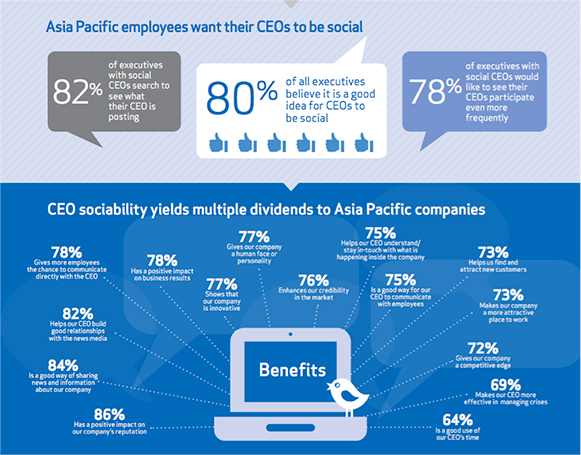
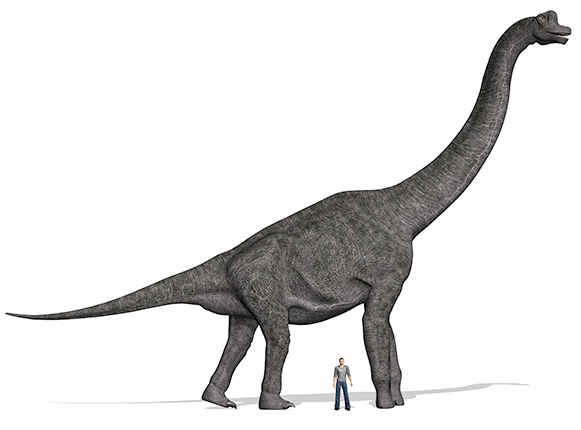

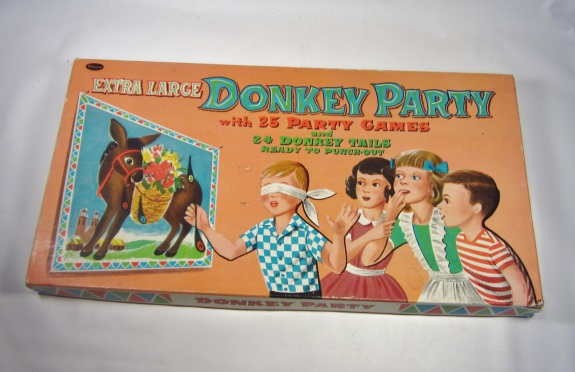



Scan the QR code for our contact details.
Download the Neoreader app.
© COPYRIGHT 2013 UNO marcomms Privacy